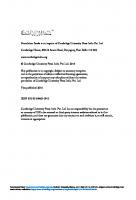Debrahmanising History: Dominence and Resistence in Indian Society 9788173046483
698 33 36MB
English Pages 455 [456] Year 2005
a007
a008
a009
a011
a012
a013
a014
a015
a016
a017
a018
a019
a020
a021
a022
a023
a024
a025
a026
a027
a028
a029
a030
a031
a032
a033
a034
a035
a036
a037
a038
a039
a040
a041
a042
a043
a044
a045
a046
a047
a048
a049
a050
a051
a052
a053
a054
a055
a056
a057
a058
a059
a060
a061
a062
a063
a064
a065
a066
a067
a068
a069
a070
a071
a072
a073
a074
a075
a076
a077
a078
a079
a080
a081
a082
a083
a084
a085
a086
a087
a088
a089
a090
a091
a092
a093
a094
a095
a096
a097
a098
a099
a100
a101
a102
a103
a104
a105
a106
a107
a108
a109
a110
a111
a112
a113
a114
a115
a116
a117
a118
a119
a120
a121
a122
a123
a124
a125
a126
a127
a128
a129
a130
a131
a132
a133
a134
a135
a136
a137
a138
a139
a140
a141
a142
a143
a144
a145
a146
a147
a148
a149
a150
a151
a152
a153
a154
a155
a156
a157
a158
a159
a160
a161
a162
a163
a164
a165
a166
a167
a168
a169
a170
a171
a172
a173
a174
a175
a176
a177
a178
a179
a180
a181
a182
a183
a184
a185
a186
a187
a188
a189
a190
a191
a192
a193
a194
a195
a196
a197
a198
a199
a200
a201
a202
a203
a204
a205
a206
a207
a208
a209
a210
a211
a212
a213
a214
a215
a216
a217
a218
a219
a220
a221
a222
a223
a224
a225
a226
a227
a228
a229
a230
a231
a232
a233
a234
a235
a236
a237
a238
a239
a240
a241
a242
a243
a244
a245
a246
a247
a248
a249
a250
a251
a252
a253
a254
a255
a256
a257
a258
a259
a260
a261
a262
a263
a264
a265
a266
a267
a268
a269
a270
a271
a272
a273
a274
a275
a276
a277
a278
a279
a280
a281
a282
a283
a284
a285
a286
a287
a288
a289
a290
a291
a292
a293
a294
a295
a296
a297
a298
a299
a300
a301
a302
a303
a304
a305
a306
a307
a308
a309
a310
a311
a312
a313
a314
a315
a316
a317
a318
a319
a320
a321
a322
a323
a324
a325
a326
a327
a328
a329
a330
a331
a332
a333
a334
a335
a336
a337
a338
a339
a340
a341
a342
a343
a344
a345
a346
a347
a348
a349
a350
a351
a352
a353
a354
a355
a356
a357
a358
a359
a360
a361
a362
a363
a364
a365
a366
a367
a368
a369
a370
a371
a372
a373
a374
a375
a376
a377
a378
a379
a380
a381
a382
a383
a384
a385
a386
a387
a388
a389
a390
a391
a392
a393
a394
a395
a396
a397
a398
a399
a400
a401
a402
a403
a404
a405
a406
a407
a408
a409
a410
a411
a412
a413
a414
a415
a416
a417
a418
a419
a420
a421
a422
a423
a424
a425
a426
a427
a428
a429
a430
a431
a432
a433
a434
a435
a436
a437
a438
a439
a440
a441
a442
a443
a444
a445
a446
a447
a448
a449
a450
a451
a452
a453
a454
a455
a456
a457
a458
a459
a460
a461
Recommend Papers

- Author / Uploaded
- Braj Ranjan Mani
File loading please wait...
Citation preview
DEBRAHMANISING HISTORY Dominanceand Resistancein IndianSociety
DEBRAHMANISING HISTORY Dominanceand Resistancein IndianSociety
BRAJRANJANMANI
MANOHAR 2005
4~ 3
~ 1-1J- lP4- I }- 0 0 c__; - --
First published2005 .
C Braj Ranjan Mani, 2005 '
All rights reserved.No pan of this publication may be reproduced or transmitted, in any form or by any means, without prior permissionof the author and the publishei:
ISBN81-7304-640-9(Hb) ISBN 81-7304-648-4 (Pb) Publiwab, Ajay Kumar Jain for
Manohar PublisheB&. Distributors 4753/23An.sariRoad.Daryaganj New Delhi 110002
Prini.eaat Lordson PublishersPvt. Ltd. Delhi 110007 '
Distribuudin Sol,rhAsJa ,,,
. FOUNP6TION ·••1
,
4381/4, Ansari Road Daryaganj,New Delhi 110002 and its branches at Mumbai,Hyderabad, Bangalore,Chennai,Kolkata
Do not believe in hearsay; do not believe in what is handed down through generations; do not believe in anything becauae it is accepted by many; do not believe because some revered aage or elder makca a statement; do not believe in truths to which you have become attached by habit; do not believe merely on the authority of your traditional teachings. Have deliberation and analyae, and when the result accords with reuon and conduces to the good of one and .all, accept it and live up to it GAUTAM
BuDDHA
The AnguuaraNika,a, I, 188, see Woodward and Hare, 1932
. . . I have the audacity to believe that peoples everywhere can have three . meala a day for their bodies, education and culture for their minds, and dignity, equality and freedom for their spirits .. I believe that what selfcentred men have torn down men other-centred can build up.. .. I still believe that we shail overcome. This faith can give us courage to face the uncertainties of the future. It will give our tired feet new strength as we continue our forward stride toward the city of freedom. When our days become dreary with low-hovering clouds and our nights become darker than a thousand midnights, we will know that we are living in the creative turmoil of a genuine civilisation struggling to be born.
MARTINLlJlliERlla:Yer, is m-yeldeYbrother. So why do you not know me, 0 Lord of theMeetingRivers?(ibid .: 52)° The 'untouchable' Madar Cannayya, idolised by Basava in the above vachana as his father, was a major Virashaiva saint ,poet. He castigates caste in one of his vachanas by presenting a remarkable line,up. of celebrated cultural personalities from the despised castes :
Sankhya was a sweeper;/Agascya , a huntsman; Duroasa,a cobbler;/Dadhichi,a _locksmith; ; Kas,apa, a blacksmith;/Romaja,a coppersmith Kaundilya,a barber; So, why shouldyou then, In ignoranceof this, Insist on caste? (Ray et al. 2000 : 480, 1) Many saints entreat their fellow beings to give up their caste identity and loyalty. In a long poem, Allama pinpoints the 'six errors' one must · overcome in order to become a truly religions person. The first major barrier, he says, is jati that hinders people to realise ·their real worth: The second fallacy is the vamashrama, dharma that gives sanctity to four caste categories and four stages of life. The other errors, according to Allama, are the pride in one's own background (kula) , lineage, name and native land (Schouten 1995: 54,5). In other words, one simply cannot become a Virashaiva without forsaking one's belief in distinctions based on caste.
DebrahmanisingHistory
166 Siddharama, Virashaiva:
for instance, asserts that caste is anathema
to a
What doesit mean to belongto thesystem of thefour castes? Look, he is a ½rashaivawhotranscendsthefour castes. (ibid.: 54) Comparing innumerable vachanas like the ones quoted above with the egalitarian Buddhist texts, Schouten points out that Basava appeared to be deeply familiar with - and influenced by - the teachings of the Buddha. This, he says, was not improbable as Buddhism was very strong in several regions in Karnataka:
... In 1095,only about ten yearsbeforeBasava'sbirth,a largeBuddhist monastery was founded in Dambal(in the present Dharwar district). Dambal later becameone ·of the most important religiouscentres of ½rashaivism. .. . The strongresistanceagainst thecaste system, as it occurredin theBuddhisttradition,was stillpreservedin thelaststrongholds of Buddhismin northernKamatakawhenBasavatriedto find an alternative for thestrictBrahmanavalt•esof hisfamily. It is an obvioussuggestionthat healsoacquaintedhimselfwiththeBuddhisttradition.In that tradition,he would certainlyhave been fascinatedby theegalitarianphilosophythat rejecteddiscriminationon thebasisof caste. (Schouten 1995: 61) A sparkling feature of Virashaivism is the strong presence of women who played a significant role in the movement. There were many influential female ascetics in early Virashaivism . There are instances of women who joined their husbands in the radical movement on an equal footing. The movement severely criticised the brahmanical legitimation of female subordination and tried to build a new vision on the man -woman relationship . It was characteristic of Virashaivism that there was place in it for the most unconventional of women like Akka Mahadevi and Muktayakka. The foremost woman among vachanakaras, Mahadevi was mainly interested in her individual redemption, but her spiritual insight has social implications. The following poem is an exquisite and typical example of this:
Those who have becomeequalby love, Should they heed backgroundor pretensions ? Those who havegonemad,
SubalternSaint-Poets
167
do theyknowshameor reltraint? Thosewho are lovedlrythe Looel-,Lord of the Jasmines, Could theyhauelcryalr,to the world?(ibid.: 30) Akka Mahadevi appears to imply here that traditional distinctions are of no value to those who experience the divine love. Background or pretensions do not matter to the true devotees, made equal for love. The word ku1aincludes all factors which are determined by birth, such as family, gender, and caste. In her own ardent style, Akka says that those besotted with divine love are like insane people who do not care for the established rules and cherished values. , The Llngayatas ado~ed a pragmatic approach to realise their ideals and came up with alt~mative rituals, ceremonies, taboos and other religio-cultural symbols. The movement not only rejected the core values and sOCialinstitutions associated with the brahmans, it also developed an institutional framework for an egalitarian order:
In its desirefor 'humanrelationships', it felt it was necessaryto breakdoom interpersonalbarriersand conventionalnorms that preventedinterpersonal contacton issueslikeinterdiningand intercastemarriage,i.e. it discarded the notionsof purir,and pollutionbetweenbrahmansand non-brahmans. It revealedtherealitieshiddenlryrituals, practices,conuentionsof brahmans, in order to be liberatedfrom the oppressionof brahmandomination. (Bali 1978: 69) The movement laid special emphasis on the dignity of labour and connected it with social progress and spiritual uplift. All people were required to work to earn their living irrespective of their status. Social mobilisation was taken up vigorously, and people were recruited to the community through the institution of math. All in all, the Virashaiva movement was a 'social upheaval by and for the poor, the low-caste and the outcaste against the rich and the privileged ... ' (Ramanujan, cited in Bali, ibid.). The aims and achievements of the Virashaiva movement were ahead of other such movements. And despite its later decline and disintegration as the movement fell victim to rigidity and social hierarchy in its own ranks against which they once fought so heroically, the Lingayatas today form the single largest ethnic group
168
Debrahmanising History
in Kamataka. Though the movement later lost its initial zeal and fervour for social change and gradually faded away, its legacy of struggle against brahmanical domination still continues. In fact, it was the community of Lingayatas that provided the core structure for the backward· classes movement in the Madras Presidency iri the twentieth century.
V ARAIn









